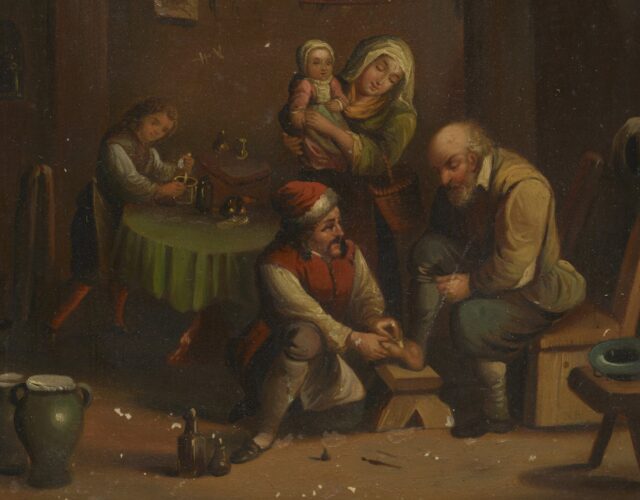When I visited my grandparents recently, I was struck by how much art was scattered around their home. As an art historian I’m predisposed to—maybe even slightly obsessed with—looking at the art people choose to live with. What is it? Where did you get it? What does it mean for you? In my grandparents’ case their art tells the story of their life as a nomadic military family. The watercolor in the sitting room is by an artist they met in Hawaii. The statuette in the china cabinet is from years spent living in Heidelberg. The same is true in my own home. Whether it’s a postcard of a painting I liked viewing in a museum or a tchotchke from a street fair, when I look at something from my collections, it immediately pulls me back to the moment I visited a new place or found something I had never seen before.
A small, unassuming painting in CHF’s collections also had a previous life as a travel keepsake. Called The Foot Operation, the piece is a loose copy of a painting by Dutch artist David Teniers the Younger (1610–1690). It is difficult to figure out exactly which painting by Teniers this one is meant to replicate because he painted at least four very similar scenes, and there are dozens of painted copies of each of the original four. Though the rough-and-tumble style of surgery depicted was already outdated in the mid-1600s, satirical imagery of barber-surgeons continued to be popular for decades.
CHF’s copy was most likely made much later, in the first half of the 19th century. By studying the painting closely conservators discovered it was painted on a thin piece of ferrous metal similar to the metal used for tintypes (a mid-19th-century method of printing photographs named for their cheap, “tinny” metal supports). Between the metal support layer and the final paint layer was another surprise—a paper print. After gluing the lithograph print down to the sturdy metal plate, all the maker would have to do was color in the composition as if filling in a paint-by-numbers kit. The paper and ink are visible in places, a result of the instability of oil paint over paper over metal.
This method of production was only possible in the early 1800s, after the lithographic print process became popular and after tin ferrous metal was readily manufactured. In fact, CHF owns seven paintings on metal that were all made using similar techniques. Unlike the original Renaissance and Baroque paintings, created slowly and laboriously for the elite, these metal paintings were an assembly-line operation, made to appeal to middle-class travelers. The cheap, efficient copies were a precursor to today’s popular museum posters and on-demand canvas prints of famous artworks.
Before the invention of photography a hand-painted copy was one of the only ways to view a painting that was too far away to visit in person or to recall one encountered while on a trip. From the end of the 1600s through the 1840s, many rich young Europeans and, later, Americans embarked on a “grand tour,” a traditional trip crisscrossing Europe to see important artistic and cultural sites. As rail and boat travel became easier and more affordable in the mid-19th century, cultural leisure trips became accessible to the middle classes as well.
This new ease of tourism meant that more people than ever before saw great works of art and architecture, though the old-money crowd was not always impressed by the manners and observations of the new travelers. Henry James lightly parodied this new culture of transnational travel and questionable art knowledge in The American, a novel about a well-intentioned yet uncouth young businessman named Christopher Newman. When Newman encounters an old-master painting at the Louvre early in the book, his impulse is to commission a copy for himself. However, Newman’s interest is only partly for the beautiful painting; he is also charmed by the pretty young woman copying it. Still, Newman loved his copy. Despite being slicked with varnish, “it looked wonderfully splendid and precious. It seemed to him a very happy purchase, and he felt rich in the possession of it.” Now he had his very own piece of the Louvre.
As to who originally purchased the Foot Operation painting and whether they “felt rich in possession of it,” we are left with more questions than answers. Copies on metal were a step down the economic ladder from Christopher Newman’s transaction with the alluring French copyist. In the case of CHF’s copy the tourist was perhaps more intrigued by the scene, a humorous take on a medical treatment thoroughly outdated by the mid-1800s. It’s fun to imagine that a traveling doctor might have chuckled at the painting’s gallows humor and wanted a copy for his office. Until we learn more I will indulge in picturing a 19th-century patient with an aching foot and his sincere hope that his doctor won’t resort to the methods displayed in the little painting hanging in the examination room.




